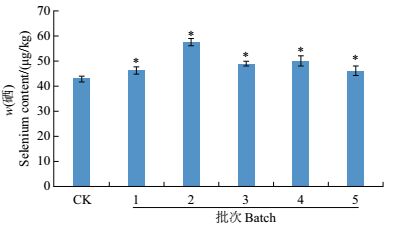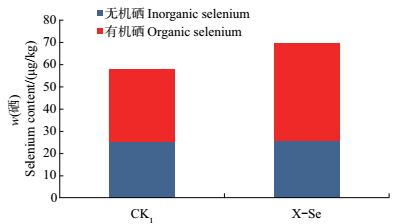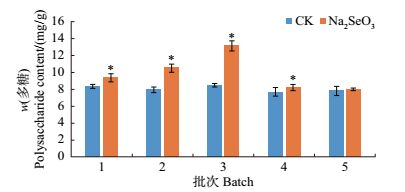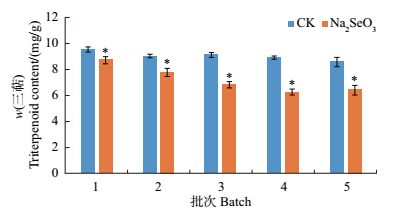| 硒对不同时期开袋灵芝主要活性成分的影响 |
灵芝(Ganoderma lingzhi S. H. Wu, Y. Cao & Y.C. Dai)作为一种传统的药用真菌,因其具有广泛的药用价值而广受人们青睐。灵芝中的主要药理活性物质是多糖和三萜。其中:灵芝三萜类化合物是一种高度氧化的羊毛甾烷衍生物,是一种重要的苦味成分,结构复杂,有较高的脂溶性,具有抗肿瘤、提高免疫力、抗氧化的功效[1];灵芝多糖类化合物是灵芝中另一种很重要的药效成分,具有抗氧化、降低血压、消炎等功效[2-3]。
硒元素由1817年瑞典化学家BERZELIUS发现,是一种生物体必需的微量元素。硒有许多重要的生理功能,如抗氧化、抗肿瘤、提高机体免疫力等[4-6]。缺硒会引起克山病、甲状腺疾病及不良情绪等[7-9]。研究认为,无机硒毒性大,吸收率较低,作用效果不及有机硒[10-11],因此,有机硒是补充硒元素最安全、最有效的选择。若能将食品中的无机硒转化为有机硒,则有利于促进机体吸收,提高作用效果。
由于动、植物生产的局限性以及生物技术的快速发展,微生物已成为硒元素的重要来源。目前,富硒酵母、富硒乳酸菌等都得到了不同程度的研究开发与利用,硒在食用菌上的研究也在不断深入。王新风等[12]通过在平菇栽培料中直接添加无机硒使其转化为有机硒,并在菇体中有效富集;黄敏文等[13]向培养基中加入一定浓度的复合硒溶液使香菇中的硒含量提高了15倍;李华为等[14]发现,对金针菇进行硒的生物有机化能提高硒含量,且其主要存在形态安全无毒。灵芝有很强的富硒能力[15],能够有效地将无机硒转化为有机硒。灵芝和硒具有许多共有的生理作用,特别是在抑制肿瘤和增强免疫活性方面。由于普通栽培的野生灵芝中硒含量很低,因此,利用灵芝进行生物富硒,一方面可以提升灵芝本身的药理和营养价值,另一方面也可以探索新的补硒途径和高生物活性抗肿瘤因子。
目前,外源添加硒对灵芝中硒含量影响的报道较多,但鲜有硒含量与菌袋开袋时间的关系及硒处理后多糖和三萜等有效成分含量变化的研究报道。本研究通过在栽培料中加入适宜浓度的亚硒酸钠,检测不同开袋时间的灵芝子实体中硒富集能力和多糖、三萜含量的变化,并利用高效液相色谱法检测三萜相似度、灵芝酸含量及三萜中关键酶基因HMGR的表达量,以期为开发富硒灵芝和拓宽补硒途径提供理论±据。
1 材料与方法 1.1 供试菌株灵芝菌株J-7/AL-2由福建农林大学菌物研究中心提供,能正常出菇。
1.2 岀菇栽培原种制备:按照配方[木屑76%(粗细木屑比为1:2),麸皮20%,玉米粉3%,石膏1%,含水量60%~65%]拌料装瓶,并用棉花塞紧加盖,121 ℃灭菌180 min。硒处理为在原配方基础上加入亚硒酸钠,使硒质量分数为50 mg/kg,进行驯化[16]。
栽培袋制备:选用37 cm×22 cm聚乙烯塑料袋,按照配方[木屑75%(粗细木屑比为1:2),麸皮20%,玉米粉3%,石膏1%,含水量60%~65%]拌料装袋。每袋装湿料1 kg,121 ℃灭菌180 min。硒处理为在原配方基础上加入亚硒酸钠,使硒质量分数为250 μg/kg[16]。于25 ℃下培养菌丝。
开袋岀菇:菌丝接种第40天开袋岀菇。添加亚硒酸钠的菌袋分5批开袋,每10 d开一次,分别记为1~5;未添加亚硒酸钠的菌袋记为CK;经原种添加亚硒酸钠驯化的菌袋记为X-Se。每个处理30个重复,岀菇温度为26~28 ℃,空气湿度为85%~90%。
子实体的采收:当灵芝芝盖边缘白色或黄色生长圈消失转为棕褐色,菌盖开始革质化,菌管层出红褐色孢子时,表明子实体成熟可采收。采收后将新鲜灵芝放入60 ℃烘箱中烘干,收集烘干灵芝并密封。
1.3 检测方法灵芝多糖的提取采用热水浸提法:准确称取2 g灵芝子实体粉末,装入加有40 mL蒸馏水的200 mL锥形瓶中,用90 ℃热水浸提4 h;收集上清液,再重复提取1次,合并2次的提取液,加蒸馏水定容至100 mL;取10 mL提取液,加入3倍体积的无水乙醇进行醇沉过夜;然后在5 000 r/min下离心10 min,弃去上清液,所得沉淀用2 mL蒸馏水溶解;最后用Sevage法去除蛋白,吸取上层清液用蒸馏水定容至50 mL。灵芝多糖的检测采用苯酚硫酸法[17],每组3个重复。
灵芝三萜的提取参考张志军等[18]的方法:准确称取2 g灵芝子实体粉末于小三角瓶中,加入50 mL85%乙醇常温浸提2 h;然后超声提取0.5 h,功率为150 W;将滤液用旋转蒸发仪60 ℃减压蒸馏去除乙醇,最后用甲醇定容至50 mL,每组3个重复。采用条件优化的香草醛-冰醋酸法[19]检测总三萜含量,用高效液相色谱法(high performance liquid chromatography, HPLC)检测三萜图谱相似度及灵芝酸含量[20]。
硒含量的检测:灵芝子实体中总硒含量按GB5009.93—2010[21]中的第一法检测;无机硒检测参考DB 3301/T 117—2007[22]。有机硒含量=总硒含量-无机硒含量。
三萜关键酶基因HMGR的检测采用荧光定量PCR法中的Livak法。按照Omega植物RNA提取试剂盒的方法提取新鲜灵芝原基RNA,并用核酸微量测定仪对提取的RNA进行浓度检测,使用北京全式金生物技术有限公司生产的cDNA第1链合成试剂盒(TransScript all-in-one first-strand cDNA synthesis SuperMix for qPCR)进行反转录。使用伯乐试剂盒进行荧光定量PCR检测,以GADPH基因为内参基因,在BIO-RAD CFX96 PCR仪上运行。
1.4 数据处理数据分析采用Excel 2003和SPSS 19.0软件;每个试验数据从30个重复中随机选取3个,结果以平均值±标准偏差表示。HPLC相似度分析利用软件的中药色谱指纹图谱相似度评价系统2004A版。
2 结果与分析 2.1 灵芝硒含量在栽培料中加入亚硒酸钠,并于不同时间开袋,发现不同批次灵芝的硒富集能力不同。如图 1所示,各个批次灵芝子实体的硒含量均有提高,但效果不同。其中接种后第50天开袋(第2批)的硒含量最高,为57.8 μg/kg,比对照高出34.42%。之后灵芝富硒能力减弱,到第5批时子实体硒含量与第1批相近。说明合适的开袋时间能够有效提高灵芝子实体的富硒能力,且供试菌株最佳开袋时间为接种后第50天。原种时期亚硒酸钠的驯化能够有效提高子实体的硒富集能力。与未经驯化的子实体相比,虽然两者无机硒含量相近,约为25.25 μg/kg,但原种驯化后子实体中有机硒含量比对照提高了35.95%(图 2)。这表明原种阶段在菌料中加入50mg/kg亚硒酸钠后进行驯化,能够有效提高子实体的有机硒含量,从而提高总硒含量。
 |
| CK:未添加亚硝酸钠。*表示不同批次与对照间在P<0.05水平差异有统计学意义。 CK: Control without sodium selenite supply. Single asterisk (*)indicates statistically significant difference between different batchesand control at the 0.05 probability level. 图1 不同批次灵芝硒含量 Fig. 1 Selenium content of different batches in Ganoderma lingzhi |
 |
| CK1:原种未经亚硒酸钠驯化;X-Se:原种经50 mg/kg亚硒酸钠驯化。 CK1: Protospecies not domesticated with sodium selenite; X-Se: Protospecies domesticated with 50 mg/kg sodium selenite. 图2 原种驯化对灵芝子实体硒含量的影响 Fig. 2 Effect of protospecies domestication on selenium content infruiting bodies of Ganoderma lingzhi |
不同批次灵芝子实体多糖含量如图 3所示。从中可以看出,前4批亚硒酸钠处理能够显著提高子实体的多糖含量,与赵镭等[23]的研究结果一致。其中:第3批的作用效果最佳,多糖含量达13.24 mg/g,比对照提高53.95%;其次为第2批,多糖含量为10.60mg/g,是对照的1.32倍;但第4、5批的作用效果降低,且第5批多糖含量与对照相近。这说明在栽培料中加入亚硒酸钠后,其子实体的多糖含量与开袋时间有关,合适的开袋时间能够有效提高富硒灵芝的多糖含量。此外,不同批次开袋的子实体三萜含量也存在很大区别(图 4)。结果显示,各个批次子实体三萜含量均显著低于对照,且开袋时间越迟,与对照的差异越大,说明硒能够抑制灵芝子实体三萜的合成。
 |
| *表示不同批次与对照间在P<0.05水平差异有统计学意义。 Single asterisk (*) indicates statistically significant difference between different batches and control at the 0.05 probability level. 图3 不同批次灵芝子实体多糖含量 Fig. 3 Polysaccharide content of different batches in fruiting bodies of Ganoderma lingzhi |
 |
| *表示不同批次与对照间在P<0.05水平差异有统计学意义。 Single asterisk (*) indicates statistically significant difference between different batches and control at the 0.05 probability level. 图4 不同批次灵芝子实体三萜含量 Fig. 4 Triterpenoid content of different batches in fruiting bodies of Ganoderma lingzhi |
利用岛津公司的高效液相色谱仪结合软件的中药色谱指纹图谱相似度评价系统2004A版分析了亚硒酸钠使灵芝子实体三萜含量降低的原因。从表 1中可以看出,各批次间灵芝三萜图谱的相似度高达98%左右;高效液相图谱(图 5)显示,各个批次出峰时间与峰型高度一致:说明不同的开袋时间对三萜中灵芝酸种类的影响较小。由图 6可知,亚硒酸钠降低了灵芝酸A、E、F的含量(P<0.05),分别比对照降低了29.03%、76.73%、80.26%,说明亚硒酸钠对灵芝酸E、F影响更大。
| 表1 不同批次灵芝三萜图谱相似度 Table 1 Similarity of triterpeniod fingerprints of different batches in Ganoderma lingzhi |
 |
| 点击放大 |
 |
| CK:未添加亚硒酸钠;S1~S5:1~5批次。 CK: Control without sodium selenite supply; S1-S5: Batch 1-5. 图5 不同批次灵芝三萜HPLC图谱 Fig. 5 HPLC fingerprint of triterpeniods of different batches in Ganoderma lingzhi |
 |
| *表示不同批次与对照间在P<0.05水平差异有统计学意义。 Single asterisk (*) indicates statistically significant difference between different batches and control at the 0.05 probability level. 图6 亚硒酸钠对灵芝酸A、E、F含量的影响 Fig. 6 Effects of sodium selenite on the contents of ganoderic acid A, E and F in Ganoderma lingzhi |
3-羟基-3-甲基戊二酰辅酶A还原酶(HMGR)催化HMG-CoA生成甲羟戊酸,再经过其他一系列酶的催化合成羊毛甾醇,最后合成具有不同结构的三萜[24]。CHAPPELL等[25]和SHANG等[26]的研究结果证明HMGR是甲羟戊酸途径中的关键酶基因。本文利用荧光定量PCR检测了三萜关键酶基因HMGR的表达量。将未添加亚硒酸钠的对照组的表达量设为1,根据2-ΔΔCT法计算添加亚硒酸钠组的相对表达量,结果如图 7所示。从中可以看出,添加亚硒酸钠组的HMGR表达量低于对照组,说明灵芝在硒富集过程中抑制了HMGR基因的表达。
 |
| 图7 亚硒酸钠对三萜关键酶基因HMGR表达量的影响 Fig. 7 Effect of sodium selenite on expression of key enzyme gene HMGR of triterpenoid |
根据已报道文献,外源添加硒能够提高灵芝中的硒含量[27-29],本研究也证实在栽培料中加入亚硒酸钠能显著提高灵芝子实体的硒含量,但不同时期开袋的各个批次间的子实体硒含量有差异。第2批(接种后50 d)的硒含量最高(57.8 μg/kg),比对照高出34.42%;第5批子实体硒含量与第1批相近,说明合适的开袋时间能够有效提高灵芝子实体的富硒能力,且供试菌株最佳开袋时间为接种后第50天。姚敏[16]报道了原种时期50 mg/kg亚硒酸钠的驯化对无机硒含量差异不显著,但并未指出对有机硒的影响。本研究发现原种加硒驯化使有机硒含量比对照提高35.95%。此外,前4批亚硒酸钠处理能够显著提高子实体的多糖含量,且第3批多糖含量达到最高(13.24 mg/g),比对照提高53.95%,与陈庆榆等[29]的研究结果一致。而第4、5批的作用效果降低,说明合适的开袋时间能够使栽培料中的硒对提高子实体多糖含量发挥出最佳的效果。在硒对灵芝营养成分的影响中,未见对灵芝三萜影响的报道。本研究检测了各个批次子实体的总三萜含量,发现处理组均显著低于对照。高效液相色谱结果显示,各批次间的灵芝三萜图谱相似度高,灵芝酸A、E、F含量显著低于对照且对灵芝酸E、F的影响更大,说明硒能够抑制灵芝子实体三萜的合成,降低灵芝酸A、E、F含量,但不影响三萜中灵芝酸的种类。此外,本研究进一步检测了三萜关键酶基因HMGR表达量的变化,结果表明硒的吸收使HMGR的表达量降低,这可能是硒降低灵芝酸含量的原因之一。
4 结论灵芝子实体的富硒能力与菌袋的开袋时间相关。随着开袋时间的延迟,灵芝富硒能力先增后减,说明合适的开袋时间能够有效提高灵芝子实体的富硒能力。在灵芝原种时期进行50 mg/kg亚硒酸钠的驯化可提高其子实体中的有机硒含量。在岀菇栽培料中加入250 μg/kg亚硒酸钠,并在接种后50 d左右开袋,灵芝的富硒能力最强。这为富硒灵芝的开发利用以及拓宽补硒途径提供了理论±据。此外,富硒灵芝中硒和多糖含量提高,而三萜及灵芝酸A、E、F含量下降,说明富硒灵芝不适合作为补充萜类物质的材料。
| [1] | LIN Z B, ZHANG H N. Anti-tumor and immunoregulatory activities of Ganoderma lucidum and its possible mechanisms. ActaPharmacologica Sinica, 2004, 25(11): 1387-1395. |
| [2] | CHEN Y, XIE M Y, NIE S P, et al. Purification, compositionanalysis and antioxidant activity of a polysaccharide from thefruiting bodies of Ganoderma atrum. Food Chemistry, 2008, 107(1): 231-241. DOI:10.1016/j.foodchem.2007.08.021 |
| [3] |
黄智璇, 欧阳蒲月. 灵芝多糖降血糖作用的研究. 食用菌, 2009, 31(1): 60-61. HUANG Z X, OUYANG P Y. Study on blood-sugar-lowering effect of Ganoderma lucidum polysaccharide. Edible Fungi, 2009, 31(1): 60-61. (in Chinese with English abstract) |
| [4] | ZHAO L, ZHAO G, HUI B, et al. Effect of selenium on increasingthe antioxidant activity of protein extracts from a seleniumenriched mushroom species of the Ganoderma genus. Journal ofFood Science, 2004, 69(3): FCT184-FCT188. |
| [5] | RAYMAN M P. Selenium and human health. The Lancet, 2012, 379(9822): 1256-1268. DOI:10.1016/S0140-6736(11)61452-9 |
| [6] |
陈玲玲, 林玲. 微量元素硒对提高人体免疫力的作用. 中国学校卫生, 2003, 24(3): 296. CHEN L L, LIN L. Effect of trace element selenium on improvingthe immunity of human body. Chinese Journal of School Health, 2003, 24(3): 296. (in Chinese with English abstract) |
| [7] |
范明慧, 范杰. 微量元素硒与克山病. 中国地方病防治杂志, 2015, 30(6): 472-474. FAN M H, FAN J. Microelement selenium and Keshan disease. Chinese Journal of Control of Endemic Diseases, 2015, 30(6): 472-474. (in Chinese with English abstract) |
| [8] | SAKIZ D, KAYA A, KULAKSIZOGLU M. Serum selenium levelsin euthyroid nodular thyroid diseases. Biological Trace ElementResearch, 2016, 174(1): 21-26. DOI:10.1007/s12011-016-0688-1 |
| [9] |
刘晓琰, 施安国. 微量元素硒的研究进展. 中国临床药理学杂志, 2001, 17(5): 375-378. LIU X Y, SHI A G. The advanced research of trace selenium. TheChinese Journal of Clinical Pharmacology, 2001, 17(5): 375-378. (in Chinese with English abstract) |
| [10] |
李改平, 刘子川, 王梦亮. 有机硒和无机硒对小鼠抗氧作用比较研究. 山西中医学院学报, 2001, 2(3): 19-21. LI G P, LIU Z C, WANG M L. Effects of organic selenium andinorganic selenium on biochemical criterions in mice. Journal ofShanxi College of Traditional Chinese Medicine, 2001, 2(3): 19-21. (in Chinese with English abstract) |
| [11] |
姚昭, 李红艳, 张云龙, 等. 有机硒、无机硒、VE单独使用及有机硒与VE联用对大鼠体内抗氧化能力的影响. 食品科学, 2013, 34(15): 272-276. YAO Z, LI H Y, ZHANG Y L, et al. Effects of Se-SMC, sodiumselenite and VE and combination of Se-SMC and VE on antioxidantdefense system in rats. Food Science, 2013, 34(15): 272-276. (in Chinese with English abstract) DOI:10.7506/spkx1002-6630-201315056 |
| [12] |
王新风, 戴传超, 蒋海龙, 等. 硒对栽培平菇产量及营养成分影响的研究. 食品科学, 2005, 26(8): 91-95. WANG X F, DAI C C, JIANG H L, et al. The effect of the Se to thefruiting-body of Pleurotus ostreatus and nutrition composition. FoodScience, 2005, 26(8): 91-95. (in Chinese with English abstract) |
| [13] |
黄敏文, 孟繁谊, 李京雄, 等. 富硒香菇中微量元素硒的含量测定. 广东微量元素科学, 2006, 13(8): 52-54. HUANG M W, MENG F Y, LI J X, et al. Determination of selenium in Lentinus edodes in selenium. Guangdong Trace Elements Science, 2006, 13(8): 52-54. (in Chinese with English abstract) |
| [14] |
李华为, 铁梅, 张崴, 等. 金针菇子实体富硒栽培特性及HPLCICP-MS法对硒的分布研究. 菌物学报, 2012, 31(1): 86-91. LI H W, TIE M, ZHANG W, et al. Se-enriched characteristics ofthe mushroom Flammulina velutipes. Mycosystema, 2012, 31(1): 86-91. (in Chinese with English abstract) |
| [15] | RZYMSKI P, MLECZEK M, NIEDZIELSKI P, et al. Potential ofcultivated Ganoderma lucidum mushrooms for the production ofsupplements enriched with essential elements. Journal of FoodScience, 2016, 81(3): C587-C592. |
| [16] |
姚敏. 富硒灵芝中硒含量分布和赋存形态研究. 上海大学学报(自然科学版), 1997, 3(5): 485-491. YAO M. Study on the distribution and combined forms of seleniumin Se-enriched Ganoderma. Journal of Shanghai University (NaturalScience), 1997, 3(5): 485-491. (in Chinese with English abstract) |
| [17] | LIU S R, KE B R, ZHANG W R, et al. Breeding of new Ganoderma lucidum strains simultaneously rich in polysaccharides andtriterpenes by mating basidiospore-derived monokaryons of twocommercial cultivars. Scientia Horticulturae, 2017, 216: 58-65. DOI:10.1016/j.scienta.2016.12.016 |
| [18] |
张志军, 朱越, 罗莹, 等. 灵芝中三萜化合物提取工艺. 食品研究与开发, 2009, 30(9): 81-83. ZHANG Z J, ZHU Y, LUO Y, et al. Optimized preparation method of triterpenoids from Ganoderma lucidum. Food Researchand Development, 2009, 30(9): 81-83. (in Chinese with English abstract) |
| [19] |
刘海良, 宋爱荣, 黄芳. 树舌灵芝发酵液中灵芝酸的提取及测定. 食用菌学报, 2008, 15(3): 68-71. LIU H L, SONG A R, HUANG F. Extraction and determination ofganoderic acid from submerged cultures of Ganoderma. Acta EdulisFungi, 2008, 15(3): 68-71. (in Chinese with English abstract) |
| [20] |
叶丽云, 林强, 刘梅, 等. 钙离子和水杨酸诱导灵芝多糖和三萜的合成. 菌物学报, 2017, 36(2): 220-228. YE L Y, LIN Q, LIU M, et al. The synthesis of polysaccharides andtriterpenoids of Ganoderma lingzhi induced by calcium ion andsalicylic acid. Mycosystema, 2017, 36(2): 220-228. (in Chinese with English abstract) |
| [21] |
中华人民共和国卫生部. 食品中硒的测定: GB 5009. 93—2010. 北京: 中国标准出版社, 2010. Ministry of Health of the People's Republic of China. Determination Sselenium in Foods: GB 5009.93—2010. Beijing: China StandardPress, 2010. (in Chinese) |
| [22] |
杭州市质量技术监督局. 稻米中有机硒和无机硒含量的测定: 原子荧光光谱法: DB 3301/T 117—2007. [出版地和出版者不详], 2007. Hangzhou Quality and Technical Supervision Bureau. Determinationof organic selenium and inorganic selenium in rice: DB 3301/T 117—2007. [S. l.: s. n.], 2007. (in Chinese) |
| [23] |
赵镭, 赵振东, 陈鹏, 等. 生物富硒对灵芝营养成分的影响. 西北植物学报, 2004, 24(7): 1275-1280. ZHAO L, ZHAO Z D, CHEN P, et al. Effect of selenium on thenutritional components of Ganoderma lucidum. Acta BotanicaBoreali-Occidentalia Sinica, 2004, 24(7): 1275-1280. (in Chinese with English abstract) |
| [24] | JOLIDON S, POLAK A M, GUERRY P, et al. Inhibitors of 2, 3-oxidosqualene lanosterol-cyclase as potential antifungal agents. Biochemical Society Transactions, 1990, 18(1): 47-48. DOI:10.1042/bst0180047 |
| [25] | CHAPPELL J, WOLF F, PROULX J, et al. Is the reactioncatalyzed by 3-hydroxy-3-methylglutaryl coenzyme A reductasea rate-limiting step for isoprenoid biosynthesis in plants?. PlantPhysiology, 1995, 109(4): 1337-1343. |
| [26] | SHANG C H, ZHU F, LI N, et al. Cloning and characterization ofa gene encoding HMG-CoA reductase from Ganoderma lucidumand its functional identification in yeast. Bioscience, Biotechnology and Biochemistry, 2008, 72(5): 1333-1339. DOI:10.1271/bbb.80011 |
| [27] |
程红艳, 孙绪春, 孟俊龙, 等. 灵芝富硒栽培研究. 安徽农业科学, 2012, 40(5): 2626-2627. CHENG H Y, SUN X C, MENG J L, et al. Se-accumulation cultivation technology of Ganoderma lucidum. Journal of AnhuiAgricultural Sciences, 2012, 40(5): 2626-2627. (in Chinese with English abstract) |
| [28] |
吉清妹, 潘孝忠, 符传良, 等. 亚硒酸钠对灵芝生长及富硒效应的影响. 沈阳农业大学学报, 2016, 47(6): 716-721. JI Q M, PAN X Z, FU C L, et al. Effects of sodium selenite on Ganoderma growth and selenium enrichment. Journal of Shenyang Agricultural University, 2016, 47(6): 716-721. (in Chinese with English abstract) |
| [29] |
陈庆榆, 孙玉军, 尹锋. 富硒灵芝中硒和多糖含量的测定. 中国林副特产, 2010(2): 16-18. CHEN Q Y, SUN Y J, YIN F. Determination of Se andpolysaccharide in selenium-enriched Ganoderma lucidum. ForestBy-Product and Speciality in China, 2010(2): 16-18. (in Chinese with English abstract) |
 2017, Vol. 43
2017, Vol. 43


